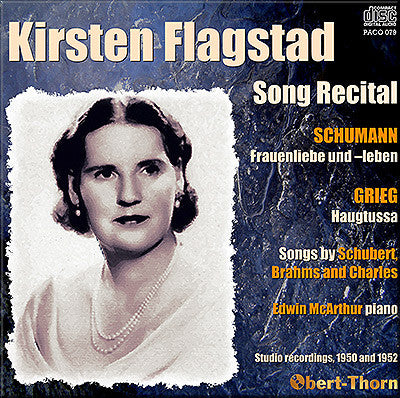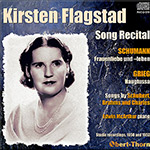
This album is included in the following sets:
This set contains the following albums:
- Producer's Note
- Full Track Listing
- Cover Art
- New tab
Long-forgotten song recitals from one of the greatest sopranos ever
Superb transfers of Kirsten Flagstad's early-50s LP releases by Mark Obert-Thorn
Flagstad’s postwar American recordings for RCA Victor, made between 1950 and 1952, form one of the least-known portions of her discography, not least because of their lack of availability for most of the past half century. Except for a 1965 LP reissue of Haugtussa and a subsequent inclusion of one of its tracks on a 1993 CD devoted to historic recordings of Grieg songs, the recordings featured here have not been available in any form since the 1950s.
The reason has less to do with the quality of the singing – after all, it was only two months after the last session on this program that Flagstad recorded her iconic Isolde under Furtwängler – but rather with RCA’s lack of interest in reissuing anything other than her Wagner recordings. (Her prewar RCA song recordings have similarly been ignored, although at least those have been reissued on CD by independent labels.) Except for the Haugtussa cycle, which Flagstad recorded on two other occasions (Victor, 1940; Decca, 1957), most of the items taped in these sessions were the soprano’s only recordings of the works, which makes their reissue doubly valuable.
This release is the first of two which will reintroduce these recordings to modern audiences. The second volume will feature more Schubert and Brahms, along with Richard Strauss and a group of songs in English by contemporary composers. Comparative listeners will note that this Haugtussa, recorded in the same Hollywood studio ten years after her initial version, runs about a minute and a half longer than the 1940 recording, while her familiar Charles encore is paced much more swiftly than its 1936 predecessor.
While the Haugtussa was transferred from the “white dog” label reissue with the benefit of somewhat quieter surfaces, the two other recital discs apparently only came out on their first-release pressings – “plain dog” labels for LM-1738 and maroon “shaded dog” for LM-1870 – which tend to be less quiet than later LP pressings, and some surface swish remains on a few tracks. Although I was able to assemble six copies of LM-1738, the actual transfer of Frauenliebe came from a single original HMV edition of the disc (ALP-1191).
Mark Obert-Thorn
1 Die junge Nonne, D.828 (Text: Craigher)
2 Die Liebe hat gelogen, D.751 (Text: Platen)
3 Die Post (Die Winterreise, D.911, No. 13) (Text: Müller)
4 Der Wegweiser (Die Winterreise, D.911, No. 20) (Text: Müller)
SCHUMANN
Frauenliebe und –leben, Op. 42 (Text: Chamisso)
5 Seit ich ihn gesehen
6 Er, der Herrlichste von Allen
7 Ich kann’s nicht fassen, nicht glauber
8 Du Ring an meinem Finger
9 Helft mir, ihr Schwestern
10 Süsser Freund, du blickest
11 An meinem Herzen
12 Nun hast du mir den ersten Schmerz getan
BRAHMS
13 Liebestreu, Op. 3, No. 1 (Text: Reinick)
14 Meine liebe ist grün, Op. 63, No. 5 (Text: F. Schumann)
15 Sind es Schmerzen, sind des Freuden, Op. 33, No. 3 (Text: Tieck)
GRIEG
Haugtussa, Op. 67 (Text: Garborg)
16 Det Syng [The Singing]
17 Veslemöy [Little Maiden]
18 Bläber-Li [Bilberry Slopes]
19 Møte [Meeting]
20 Elsk [Love]
21 Killingsdans [Kidlings’ Dance]
22 Vond Dag [Evil Day]
23 Ved Gjætle-Bekken [At the Brook]
24 Ernest CHARLES: When I have sung my songs (Text: Charles)
Tracks 1-12: Recorded 17 March 1952 in RCA Studio No. 2, New York
Tracks 13-15: Recorded 10 April 1952 in RCA Studio No. 2, New York
Tracks 16- 23: Recorded 26 April 1950 in the RCA Studios, Hollywood
Track 24: Recorded 18 March 1952 in RCA Studio No. 2, New York
Tracks 1-4 and 13-15 first issued on RCA Victor LM-1870
Tracks 5-12 and 24 first issued on RCA Victor LM-1738
Tracks 16-23 first issued on RCA Victor LM-1094
Kirsten Flagstad soprano
Edwin McArthur piano
Special thanks to Maynard F. Bertolet and Howard Sanner for providing source material
Total duration: 76:59
Cover artwork based on a photograph of Kirsten Flagstad
Producer and Audio Restoration Engineer: Mark Obert-Thorn
Audiophile Audition review
Just the kinds of vocal elegance and virtuosity in which Flagstad exhibits as much restraint as she does vocal prowess
The art of Kirsten Flagstad (1895-1962) receives excellent service by way of Pristine and master restoration engineer Mark Obert-Thorn, who revive inscriptions the great Norwegian soprano made for RCA, 1950-1952. The original vinyl LPs from which many of the songs derive have passed into obscurity, since RCA seems to have lost interest in Flagstad’s post-war efforts...
The Schubert (17 March 1952) and Brahms (10
April 1952) provide just the kinds of vocal elegance and virtuosity in
which Flagstad exhibits as much restraint as she does vocal prowess.
Schubert’s “Die junge Nonne” offers another of his ‘dark and stormy
nights’ narratives that could bathe in ‘religious’ treacle, if
permitted. Of the Brahms group, “Meine liebe ist gruen,” Op. 63, No. 5
bursts forth with a vehemence not easily matched, either by the composer
or fellow vocalists. The “Sind es Schmerzen, sind des Freudes,” Op. 33,
No. 3 offers wonderful accompaniment from McArthur, the song taken from
the Tieck cycle of courtly love and loss, Die Schoene Magelone. The
tissue of medieval ardor that Flagstad and McArthur weave suggest that
this opus stood as his personal version of Tristan.
Gary Lemco, Audiophile Audition

